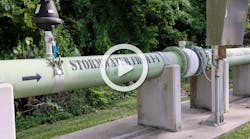About the author: Tom Happel is president of Suntree Technologies Inc. Happel can be reached at 321.637.7552 or by e-mail at [email protected].
Related search terms from www.waterinfolink.com: NSBB, fecal coliform, nutrients
The McKamey Animal Care and Adoption Center (MACAC) in Chattanooga, Tenn., is a nonprofit, state-of-the-art facility that is dedicated to the welfare and care of animals. The 26,000-sq-ft facility is located on 10 acres of land.
MACAC has the capacity to be a temporary home for 500 individually caged animals. There are 22 separate outdoor artificial turf exercise areas with storm drains that receive rainwater runoff and hose-fed washdown water.
Any large animal facility is a potential pollutant source for fecal coliform and nutrients. Gary Moody of W.I.S.E. Hydrology was tasked with developing a pollution control plan that would enable MACAC to sanitarily operate without discharging pollutants off site.
Nature & Technology
W.I.S.E. Hydrology specializes in combining natural processes with modern technology to form treatment trains that handle storm water pollution. The solution Moody developed for MACAC included a specialized version of a Suntree Technologies nutrient-separating baffle box (NSBB), a lateral ex-filtration field with plants for bioremediation and a wetland treatment pond. JenHill Construction Materials constructed and installed the treatment train.
The volume of the NSBB and the lateral field is sized to hold the first 0.75 in. of rain, and the entire treatment system with the wetland pond is sized to treat and hold a 25-year rain event. The water flow from all the storm drains in the animal areas is collected in a single conveyance leading to the NSBB. All the storm drain pipes are oversized, and minimal slope increases residence time within the pipe system before entering the NSBB.
Nutrient Separation
As shown in New Jersey Corporation for Advanced Technology (NJCAT) testing, the NSBB can be used as a stand-alone treatment system or as pretreatment for another technology. For MACAC, it will act as both pretreatment for the lateral ex-filtration field during low to medium rain events and as pretreatment for the wetland pond during large rain events.
At the outflow end of the NSBB are two outflow pipes—a side outflow pipe leading to the lateral field that has an invert 12 in. below the top of the baffles, and an outflow pipe in the end of the vault that is even with the tops of the baffles and leads to the wetland pond. In each baffle there is a skimmer-protected 4-by-4-ft opening that allows small water flows to pass through the baffle rather than over it, ensuring that water that has been in the NSBB since the previous rain event is directed into the lateral field before new rainwater.
As water enters the NSBB, solids are separated from the water flow by a 0.25-in. sieve-size screen system. These collected solids will remain in the screen system between rain events and are stored in a dry state above the static water level in the vault. Smaller solids will pass through the screen system and be captured in the lower settling chambers. As indicated in NJCAT testing, the NSBB is effective in removing solids as small as 18 microns without any significant resuspension.
In front of the outflow pipes is a floating skimmer system known as SkimBoss; it has the ability to stop any lighter-than-water liquids such as oil or tiny floating debris that may pass through the screen system.
Additional Treatment
Because the outflow leading to the lateral field has a lower invert than the outflow leading to the wetland pond, initially all the water that enters the NSBB will be directed into the lateral field. The lateral field has a total of 400 ln ft of 10-in.-diameter perforated fabric-covered pipe in 2-sq-ft trenches surrounded by clean sand. Each run of lateral field is connected by crossovers to ensure an even distribution of water flow throughout the lateral field, with cleanout and inspection ports in the ends of each run.
Microorganisms within the sand of the lateral field continuously consume the pollutants conveyed in the storm water, sustaining the treatment potential without a need for maintenance. Buffalo grass was planted on top of the lateral field to contribute to the bioremediation and transpiration of moisture. The buffalo grass requires no maintenance, and the roots extend 14 to 20 in. in the area around the trenches. A spunbonded geotextile keeps roots out of the lateral field. In addition, the pre-existing plants and trees in the vicinity will contribute to the function of the lateral field.
Larger rain events that generate more storm water runoff than can be stored in the NSBB and lateral field are flowed through the NSBB for pretreatment and then into the wetland pond. The wetland pond is a closed system and does not have an overflow connecting it to another downstream conveyance or storm water system.
Treatment in the wetland pond begins by selecting and planting a variety of proper, native wetland plants with known removal efficiencies and transpiration rates. A well-vegetated wetland pond will uptake a portion of a nutrient pollutant load into the plant matter and oxygenate the water to allow good microorganisms to flourish and contribute to bioremediation.
Testing
Part of the storm water permit requirements is that MACAC provide third-party monitoring to substantiate that the storm water treatment system is performing as expected and within municipal and federal guidelines.
The monitoring included testing and documenting the quality of the water flowing into the NSBB, exiting the NSBB and in the wetland treatment pond 25 ft away from its outfall.
The water was tested for fecal coliform, total phosphorus, Kjeldahl nitrogen and pH. After six months that included many significant rain events, water quality testing indicated significant reductions (see Figure 1, page 15).
The water quality test data results are better than expected, and all the storm drains are flowing properly. There is no ponding above the grates or any indication that water is backing up within the treatment train.
MACAC can stay focused on doing what it does best—providing for the care and well being of animals of Chattanooga—knowing it has a silent and self-sustaining partner built into the infrastructure of its facility.
Download: Here

